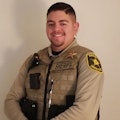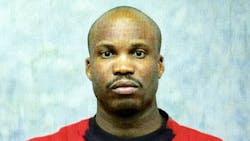How to Catch A Criminal: Serial Killer's Map Leads FBI to Him
What to know
• In May 2001, the bodies of sex workers were discovered around St. Louis, leading authorities to believe they were dealing with a serial killer, dubbed "The Streetwalker Strangler."
• A year later, a local newspaper received a letter from a man claiming to be the killer of two of the victims, and he included an internet-printed map to the locations of another victim to prove his veracity.
• But that map proved to be the 36-year-old serial killer's undoing, as the FBI used his IP address from the map search to find his home, which included a basement torture chamber and a video collection of what he did to his victims.
Every officer with a decent amount of time on the job knows the unexpected turns an investigation can take. Seeing a major case through to completion often involves giving up on a theory and taking your investigation in a different direction as new information becomes available. In How to Catch A Criminal, we look at the many ways not-so-perfect crimes are solved. This month, a killer gives investigators a map that leads directly to him.
Serial killers, as we know, seek the thrill and satisfaction they feel from taking a life, torturing a victim, feeling control over another person, etc. Many times, that thrill seeking manifests as a need for recognition. Take the Zodiac Killer for example, publicly announcing his existence by demanding his taunting messages and ciphers be printed in the newspaper, or there would be more death. Then there are those who are so excited by their infamy they practically insist on being caught. Dennis Rader, the BTK Killer, began taunting investigators through letters and asked if a floppy disk could be traced. Naturally, they told him it would be untraceable and then traced deleted files from a floppy disk he sent. The deleted files provided his name and led them to the computer he used, ending his murder spree in short order. Sometimes a killer’s desire to be known grows so strong it crosses the line into a desire to be caught.
On May 15, 2001, a woman’s decomposing body was discovered on the side of a road in West Alton, Missouri, about half an hour North of St. Louis. Investigators scoured the area for forensic evidence to determine what happened to the woman but quickly ran into a speed bump. The roadside was a secondary site, meaning whatever happened to this woman, occurred elsewhere, and she was dumped their postmortem. That also meant the usual treasure trove of evidence found at a homicide scene was out of the search for investigators. Thanks to dental records, the deceased woman was soon identified as 36-year-old Teresa Wilson. Wilson was known to struggle with drug addiction. In order to support her daughter and fund her drug habit, Teresa turned to prostitution. This was certainly a high-risk endeavor in St. Louis at that time. In fact, in the months prior, the bodies of several black woman, known to have worked as prostitutes, had been turning up around the greater St. Louis area. This included the bodies of Alysia Greenwade and another unidentified woman in Washington Park, just over the Illinois border that April. Up to this point, Law Enforcement hadn’t made a connection between the victims. This was likely because the area is made up of numerous municipalities, all bunched close together. Though many of the bodies were close in proximity, the various Police Departments and Sheriff’s Offices in the area hadn’t been handling them on a case-by-case basis. The victims were always found nude, decomposing, usually with obvious signs of strangulation.
On May 23, 2001, the body of Betty James was found in the same area as Alysia Greenwade. A little over a month later, a mere 16 feet away from the dump site of Teresa Wilson, investigators found and identified the body of 46-year-old Verona Thompson. The similarities were indisputable, and it was evident the murders were the work of one culprit. The FBI was called in to create a task force and head the investigation as the number of victims attributed to the “The Streetwalker Strangler” continued to climb, perhaps dating back to the Summer of 2000, when 61-year-old Mary Shields was found dead in East St. Louis. The task force spent the rest of 2001 and early 2002 chasing leads to no avail. The first and biggest break came in March of 2002 when the St. Louis Post-Dispatch ran a story memorializing Teresa Wilson, nearly one year after her murder. The audacity of the newspaper to humanize the murder victim drew the ire of the Strangler himself.
On May 25, 2002, the Post-Dispatch received a letter which read, “Nice sob story about Teresa Wilson. Write one about Greenwade. Write a good one, and I’ll tell you where many others are. To prove I’m real, here’s directions to number seventeen. Search a 50-yard radius from the X. Put the story in the Sunday paper like the last.” The letter included a map of the St. Louis area from Expedia.com. There was an “X” over part of West Alton. Sure enough, investigators located another body there, an unidentified female. The strangler called her number seventeen, but the official number of victims attributed to him was far less. Investigators hoped he was embellishing to stroke his own ego but couldn’t help but worry that he had been far busier than they first imagined. Regardless, they desperately needed a break in the case, and unbeknownst to the cocky killer, he had just given them everything they needed.
In 2002, the internet was still in its infancy. The convenience of printing directions from a website, rather than navigating with a physical map like Christopher Columbus, was all the rage. Evidently, The Streetwalker Strangler was a modern man, utilizing Expedia.com to map his crimes. What he did not grasp, however, is the permanence of everything that has ever taken place online. Before the days of VPN’s, everything done online from your home computer could quite easily be traced right to you. Unlike the Strangler, the FBI was well aware of this and reached out to Microsoft, the parent company of Expedia at the time. Microsoft found only one IP address had searched for that area of the St. Louis map recently. That information led agents, armed with a search warrant, to the Ferguson, Missouri home of 36-year-old Maury Travis, on the morning of June 7, 2002. Travis made it clear that he did not appreciate being woken up early, but he knew why they were there. The home appeared immaculate, on the upper floor, but the basement was a different story. There, they found a collection of VHS tapes, as well as a locked room containing restraints, with blood spatter on the walls. Travis was arrested on the spot and promised to confess everything once he had an attorney. He was formally charged with two federal counts of Kidnapping Resulting in Death, due to crossing state lines with two of the victims.
Each of the VHS tapes found in the basement contained a literal nightmare. Maury Travis had lured his victims to his home to solicit their services, at which point he would trap them in his basement torture chamber. He would bind them, rape them, and abuse them physically and psychologically. He filmed the things he did to the women, forcing them to call him “Master” and made them repent for being drug addicted, absent mothers. He told the victims he planned to kill them while they were captive, and forced them to live their final days, waiting for him to take their lives at any moment. As investigators worked to use DNA to connect Travis to twelve known victims of the possible seventeen, he claimed, he took matters into his own hands. Three days after his arrest, Travis hanged himself in his jail cell. His death left many questions unanswered, both about himself and his motivations. Travis had previously served prison time for robbing shoe stores, and for twice violating probation due to drug possession. Other than that, he was just a waiter at a hotel restaurant, whose ego and depravity couldn’t tolerate people treating his victims like they were daughters, mothers, or anything more than what he saw them for. Many of the women in the torture videos, as well as many of the victim’s bodies, have yet to be identified.
About the Author

Officer Brendan Rodela, Contributing Editor
Brendan Rodela is a Sergeant for the Lincoln County (NM) Sheriff's Office. He holds a degree in Criminal Justice and is a certified instructor with specialized training in Domestic Violence and Interactions with Persons with Mental Impairments.

